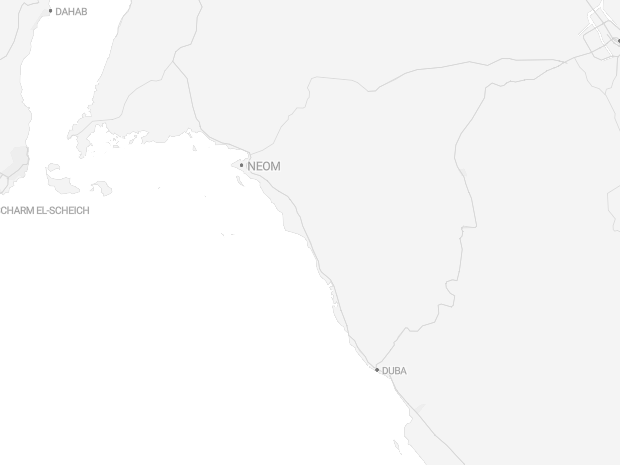The planned metropolis of Neom is to become the global hydrogen center. Satellite images show how the Saudi government is demolishing villages belonging to the local Howeitat tribe to make way for the city from the drawing board. And not far away, it is building a huge hydrogen production plant with Thyssen-Krupp.
“Economy from above” is a collaboration between WirtschaftsWoche and LiveEO. This is a translation of the original article written in German by “Thomas Stölzel“. Access the original article here.
After years of announcements, Saudi Arabia’s royal family is apparently getting serious about building Neom – a planned megacity of the future and hydrogen capital of the world. The latest satellite images show that construction workers have demolished several villages north of Neom’s airport in recent months. Also, ten minutes away by car, according to LiveEO’s images, huge bed castles have been built for workers who are to build the future metropolis. And a few kilometers to the south, the first hydrogen billion-dollar project has been under construction for a few days.
Saudi Crown Prince Mohammed bin Salman presented the Neom project to the public back in 2017. It is intended to pave the way for Saudi Arabia out of the oil age and into the age of renewable energies. A 26,000-square-kilometer area on the northern shore of the Red Sea has been reserved for this purpose.
Some time ago, satellite images there had only shown that a new royal palace with villas and a golf course as well as an airport had been built. There was still no sign of the green hydrogen future or solar plants.
The Most Important Places in the City of the Future

Now, however, several settlements have been razed to the ground. Satellite images of the village of Sharma from two years ago, for example, show hundreds of walled residential buildings typical of the region, as well as a hospital.
In the meantime, almost all the buildings and walls have disappeared, the former residential plots covered by desert sand. The Saudi government has forcibly relocated the inhabitants. It is not clear from the photographs where they have been moved to.
.jpeg)
.jpeg)
The residents of the neighboring village of Alkhuraybah, which lies to the northwest of Sharma, apparently fared no differently. Here, too, recent photographs show that the number of houses has been gradually reduced in recent months, and now only a few remain standing.
In April 2020, Saudi security forces had shot and killed activistAbdul-Rahim Al-Howaiti here when he protested the forced relocation of Alkhuraybah residents and refused to leave his home. This had caused horror among critics of the country.
{{inline}}
The area was previously inhabited mainly by members of the Howeitat tribe, which also inhabits the Sinai Peninsula and parts of Jordan. The British officer, archaeologist, secret agent and writer T.E. Lawrence, also known as Lawrence of Arabia, had once cooperated with the tribal elders of the area during the First World War.
Today it is also Germans who are doing business here. Last Tuesday, the foundation stone was laid for a five-billion-dollar plant for the production of green hydrogen, in which the electrolysis subsidiary of Thyssen-Krupp, Thyssen-Krupp Uhde, is also involved alongside the U.S. company Air Products. According to geospatial data provided by the company, the plant is being built in the immediate vicinity of the deepwater port of Duba, about 65 kilometers south of the Royal Palace, the former heart of Neom. The project is headed by ex-RWE CEO Peter Terium, who is expected to build Neom’s energy division. The green gas is to be exported via the deep-sea port from 2026.

In addition, huge workers’ camps have grown up around Neom in recent months. For example, at the deep-sea port. But also a few minutes by car from Sharma, inland behind a rocky chain of hills.
Hundreds of two-story residential barracks and associated soccer fields now stand here. According to Arab media reports, a single camp can house up to 10,000 workers.
However, there is also criticism of the living conditions in the camps. Human rights activists complain that up to six workers, who often come from Pakistan and India, are crammed into a very small space. The organization FairSquare wrote in a report that Saudi citizens consider construction work beneath their dignity, so cheap labor from abroad is used in Neom. Megaprojects like this cannot be implemented without a massive number of low-income workers, the report added.
Nevertheless, Germany and Europe will have to rely on green hydrogen from Neom in the future if they want to achieve their climate targets in the medium term without crippling their own economies. Especially since Russia will no longer be a supplier of natural gas in the medium to long term. The new hydrogen production facility now being built in Neom is expected to export the first green gas in 2026. Thanks to cheap solar energy, it will be possible to produce this in Neom at much more competitive prices than in Germany, for example.







